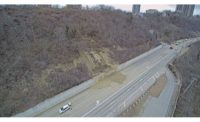Chicago's Lake Shore Drive Bridge Closes for Emergency Repairs, Reopens With Temporary Fix
Chicago River span shut for 24-plus hours for cracked steel girder repairs




Lake Shore Drive, a part of U.S. Highway 41 that runs parallel with and along the shoreline of Lake Michigan in Chicago, was closed to northbound traffic from the morning of Feb. 11 to the afternoon of Feb. 12 due to cracks in structural steel support girders on the elevated roadway leading up to the Outer Drive Bridge that crosses the Chicago River near the mouth of Lake Michigan. The popular thoroughfare handles 120,000 vehicles a day, half of which use the northbound lanes.
Crews from general contractor F.H. Paschen, steel erector Metropolitan Steel as well as Chicago Transit Authority ironworkers completed two 12-hour shifts to install four steel structural support towers underneath a portion of the drive where cracks were observed in steel girders that support the road as it elevates and approaches the Outer Drive Bridge — a 264-ft-long, double-deck, double-leaf bascule bridge over the Chicago River where it meets the mouth of Lake Michigan. Chicago Dept. of Transportation Director of Public Affairs Michael Claffey said the cracks were detected by a CDOT crew making traffic signal repairs on the lower portion of Lake Shore Drive around 10 a.m. Feb. 11. Shortly thereafter, city officials shut down the road for repairs.
The four new temporary towers can support more than 1.2 million lbs of pressure, according to CDOT, and the roadway was elevated about six inches during the repairs to fix a dip that occurred in it as a result of the cracked structural girders.
"We think this was caused by the combination of corrosion coupled with the extreme temperature swings [temperatures swung from -20° to 45° F in Chicago in early February]," Claffey said in a statement to ENR, noting that the new towers are a temporary fix and Paschen, CTA iron workers and CDOT are working on permanent repairs to the steel girders that should be completed in the next few weeks. "For the permanent repairs we will use a pair of steel plates and they will be attached to the existing girders to re-establish and strengthen the connection point."
Claffey said CDOT has completed a full inspection of the structure to determine if there are any other trouble spots and the agency will be closely looking at the structure while working on the permanent repairs.
The 33-year-old bridge structure was last inspected in June 2017 on its regular bi-annual schedule set by federal bridge inspection standards and it was due to be inspected again on this schedule this coming June. The 2017 inspection found that it was rated in fair condition, receiving a rating of 5.
Bridge condition, as measured by the Illinois Dept. of Transportation, is determined by the lowest condition rating of the primary components of a bridge or culvert. The lowest condition rating of the deck, superstructure, substructure, or culvert. If the lowest rating is greater than or equal to 7, the bridge is classified as good; if it is less than or equal to 4, the classification is poor. Bridges rated 5 or 6 are classified as fair.
According to the 2018 Association of Road and Transportation Builders Association Bridge report, of the 26,775 bridges in Illinois, 2,303, or 8.6%, are classified as structurally deficient. This means one of the primary components is in poor or worse condition.
The Outer Drive Bridge does not meet federal requirements for new bridges, and the Federal Highway Administration considers it “functionally obsolete” when compared to modern bridge design.
"[This is an example] of what happens when Springfield and Washington legislators utterly fail to address Illinois’ infrastructure needs,” said Illinois Road and Transportation Builders Association President and CEO Mike Sturino. “The time to act is now.”
IDOT Saw all of its projects shut down in 2017 due to a budget stalemate in Springfield between Illinois House Speaker Michael Madigan (D) and former governor Bruce Rauner (R).
Lake Shore Drive has seen no major modifications since its s-curve was removed in a $78-million, four-phase project that began in 1982 and was completed in 1986 [ENR Oct. 25, 1984]. The s-curve was replaced by the Outer Drive Bridge's modern southern approach which is the roadway-to-bridge structure with the girders that cracked last week.
Engineer Alfred Benesch & Co. designed the renovation of the then-48-year-old Outer Drive Bridge which created space for the eight 12-ft lanes of both the bridge and Lake Shore Drive's upper roadway and created a then-new six-lane lower roadway and the combination of bike paths and sidewalks that Chicagoans use to access Navy Pier, Lake Point Tower and Oak Street Beach. Benesch began design work on the bridge in 1975 and Paschen began construction of the project in 1982 which was completed in 1986. All that remains of the old s-curve is a part of the modern Wacker Drive. With the exception of new northbound lanes further south near Soldier Field that were installed in 1996, Lake Shore Drive has seen no updates other than routine maintenance since.








